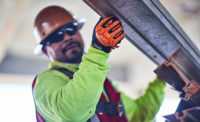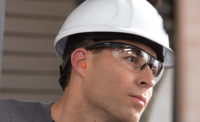It’s been a very active year for my OHS consulting business. I’ve reached the top of my hotel loyalty membership benefits. If a suite is available at check-in, I’m upgraded at no extra cost. Although I’m pleased with the added space, I accept the room knowing there’s an increased risk to my health and safety. How’s that?
Most hotel suites include a plush chair and couch, sometimes made of leather but more often covered in cloth fabric. Hotels routinely apply fabric refresher to these items to mask or eliminate odor. But they deep clean cloth chairs and couches, under cushions and all, about as often as you do at home. Lack of deep cleaning and other actions/inactions help unwanted guests in the room, such as bed-bugs and germs, to multiply and spread to bedding and even packed clothes.
With the global rise of bed-bug infestation, experts, such as the EPA1 and Consumer Reports2, say when you enter any hotel room, immediately place your luggage into the bathroom and check the room for bed-bugs. The hotel bathroom is the least likely location for bed-bugs; that’s why you keep luggage there first.
A feast for bugs
I was not vigilant one night in heeding expert advice. The picture accompany this column (day-three) following itching, typical breakfast, lunch and dinner bed-bug bite marks. The bugs feasted on other areas of my body, too.
Realizing what happened, I informed the hotel and moved to another room (that I checked thoroughly) and continued my road-warrior work. When I arrived back home a couple days later, I thoroughly washed all clothing to avoid bringing a bed-bug infestation into my home.
Would you have done anything different from my actions?
Price of mobility
Injury and illness is mostly an odds game. Increase the frequency to a hazard and failure to achieve the objective of staying safe and healthy is diminished. Hazards, however, are not static. Hazards sometimes are created or increased by unintended actions. For example, why is there an increase in bed-bug infestation, particularly in advanced countries, such as the United States?
According to Strategic Analytics3 the mobile workforce will increase to 1.87 billion by 2022 and account for 42.5 percent of the global workforce. Electronic technology, with all it does and may do, facilitates a mobile workforce.
Businesses that service the mobile worker are growing but most operate in a lean, competitive mode, with generally high worker turnover in the service industries. Most hotels don’t deep clean items such as couches or hire highly skilled workers because doing so would place them at a competitive disadvantage in costs. Reduced costs of travel help increase the number of mobile workers.
The problem of bed-bugs has been known for centuries. The use DDT and Malathion nearly eradicated the bugs shortly following WW II. During the past couple of decades, however, particularly in advanced countries, safer pesticides and altered use pesticides i.e. targeted rather than broad application, coupled with bug resistance to safer pesticides, have allowed bed-bugs infestations to re-emerge. Complacency, that caused me to be bit, results in my increased attention to the problem.
Context
The brief explanation above why bed-bugs are a growing problem is an example of risk context. Recognizing and managing context is a central obligation in modern international standards such as ISO 9001, 14001, 31001 and upcoming 45001, occupational health and safety management systems. Beyond bed-bugs, what are other hazards, brought about by a growing mobile workforce, should the OHS pro consider?
This year people have died from carbon monoxide poisoning at hotels, hotel guests had to shelter in place from chlorine leaks, national restaurant chains have experienced food-borne illness, and assaults and thefts among mobile travelers are on the rise. What about the road risks of driving and such? These are the tip of the iceberg of hazards.
Assistance
Unless the employer has a large mobile workforce, OHS pro assistance to their road warriors is sparse; it’s more productive for the pro to serve the many rather than the few. Typically, however, pro assistance comes mostly from the bottom of the hierarchy of controls e.g. training. Consequently, many mobile workers must be attentive to their own well-being. It shouldn’t be this way. All workers must be afforded reasonable OHS protections, even when the workplace could be any place.
Recommendations
- Advise your boss that you’re considering the following recommendations.
- Determine who is a mobile worker, even briefly, within the organization.
- Contact these workers (many who may be on the road and some who are at the executive level) and give them an update on the rise of bed-bug infestations.
- Once alerted to bed-bugs, ask them to provide a list of any additional mobile hazards they feel should be evaluated. Providing the workers with a checklist of possible hazards will facilitate their thinking. Ask mobile workers to include any near-miss experiences (they may need an explanation of what you mean by near-miss). These actions will build your list of recognized hazards.
- Provide a summary evaluation of the hazards; and resend to the workers for re-consideration. This action usually brings a few new hazards to the list.
- Seek the mobile workers’ input for reasonable controls, if any. This action helps reframe hazards and supports buy-in and acceptance for improvements.
- Summarize the above in a report to your boss. Suggest in the summary report that a new or updated OHS policy and procedure for mobile workforce may be needed.
- The boss should brief senior management on initial direction of the project. Other management areas should be asked for input.
- Obtain approval to provide each mobile worker with a small emergency kit, initially with first-aid supplies and some brief training material. Providing mobile workers an emergency kit and training briefs will demonstrate management commitment to improved OHS.
- Generally, defensive driving and security precautions will be at the top of mobile workforce concerns. Food safety e.g. hotel breakfast bars and buffets may surprisingly be high on the list. Don’t be surprised if some mobile workers freak-out about bed-bugs.
- Resist the urge to provide black lights (small flash lights now mostly under $20) for germ identification. Black light findings may freak mobile workers more than needed. Loaning a few of these lights out to some travelers may have a positive benefit, however.
- Increasingly, most of your mobile workforce will be millennials. Millennials often have a lower risk tolerance than seasoned older travelers. Differences in risk perception should be anticipated and addressed.
With more than four in every ten of all workers being part of the mobile workforce in the next five years, it’s now time for every OHS pro to up their game in this hazard topic. And as you travel, remember the adage, “Sleep tight, don’t let the bed-bugs bite!”
References
- https://www.epa.gov/bedbugs
- https://www.consumerreports.org/pest-control/how-to-protect-yourself-against-bed-bugs/
- https://www.strategyanalytics.com/strategy-analytics/news/strategy-analytics-press-releases/strategy-analytics-press-release/2016/11/09/the-global-mobile-workforce-is-set-to-increase-to-1.87-billion-people-in-2022-accounting-for-42.5-of-the-global-workforce#.Wc-xdGhSyM8




